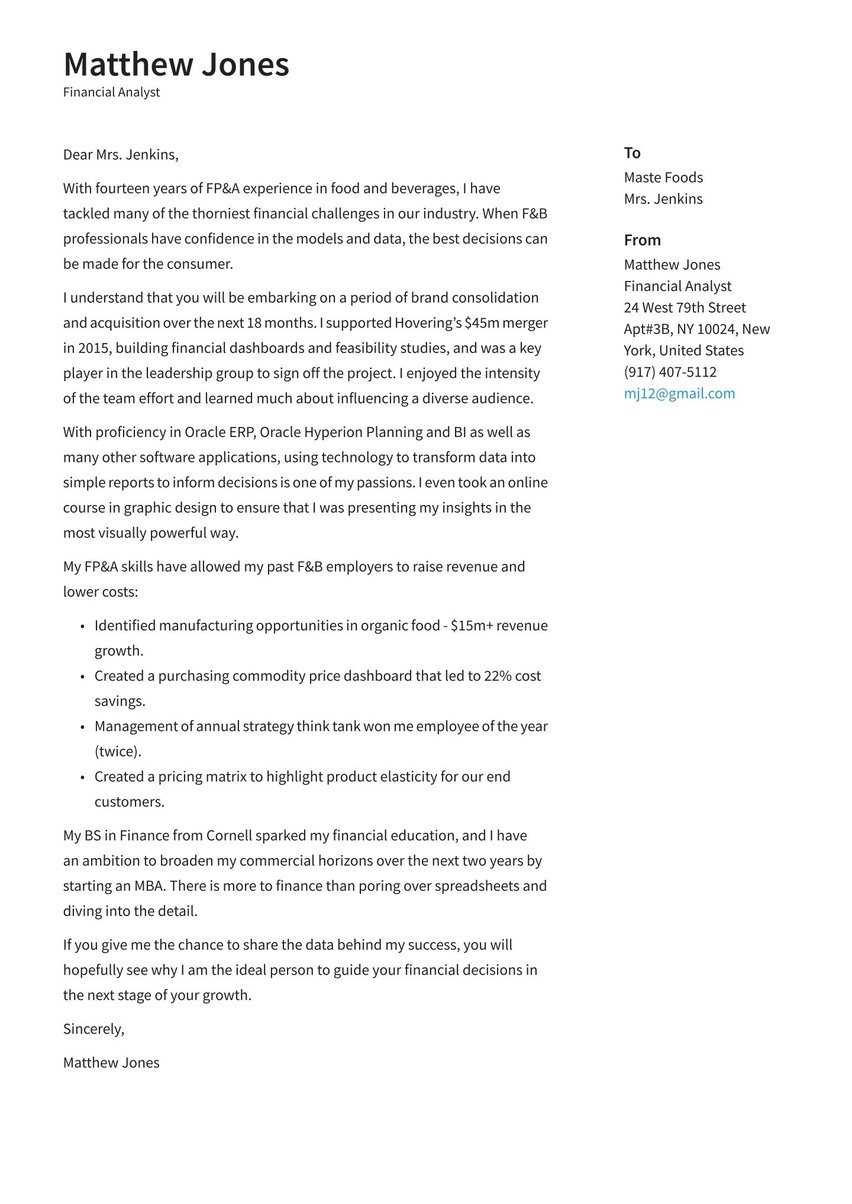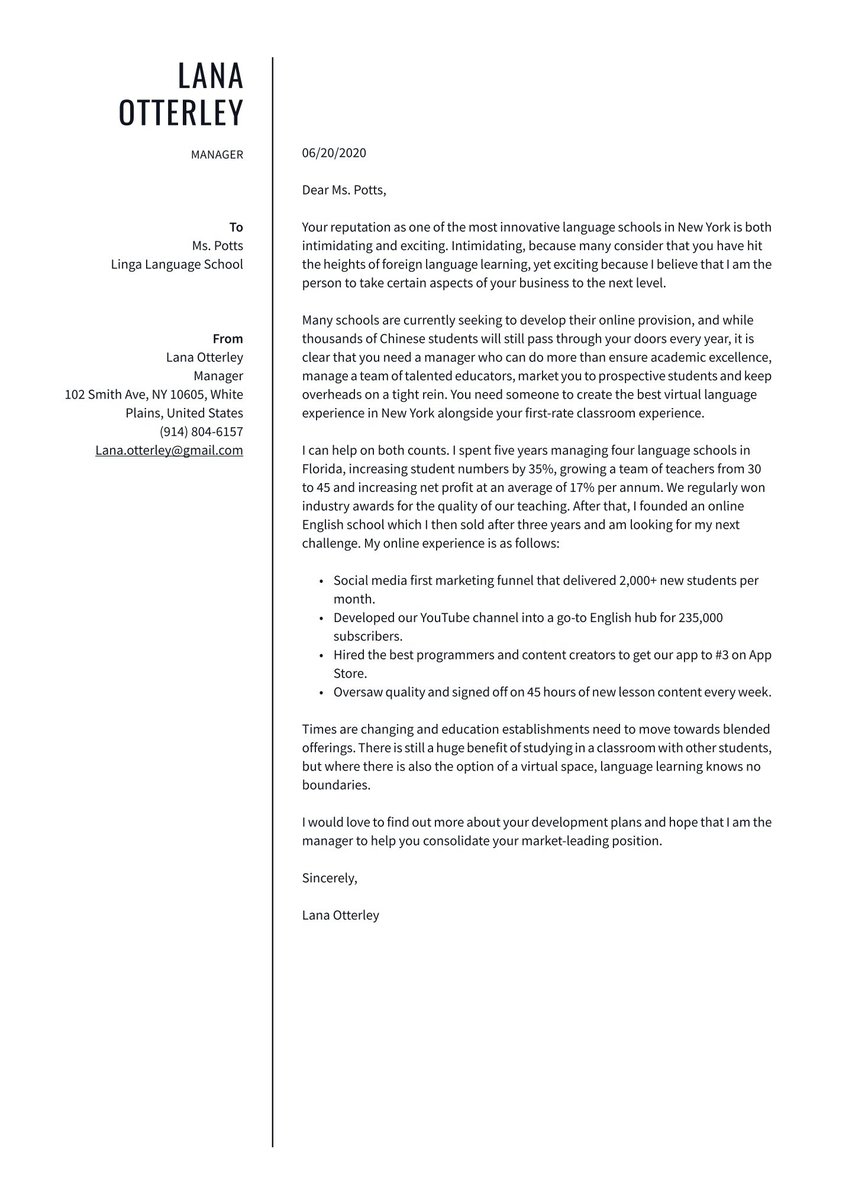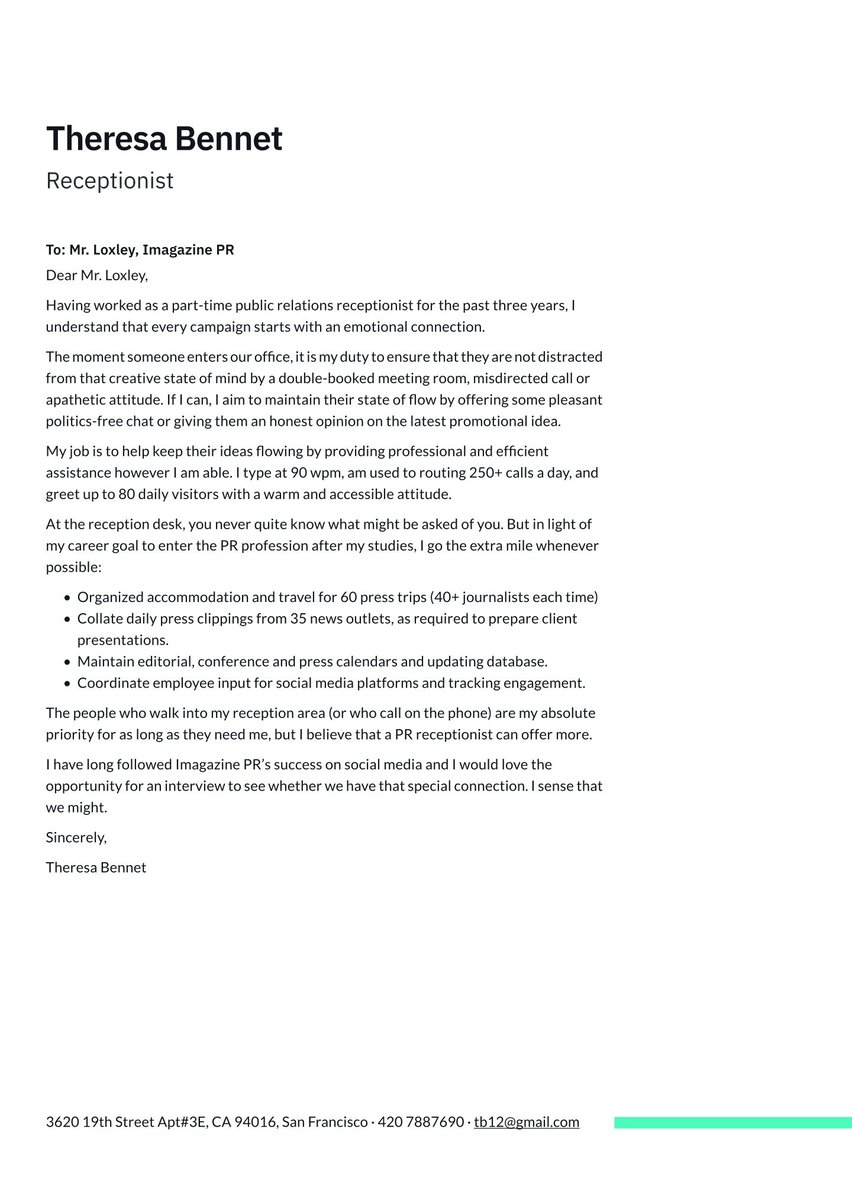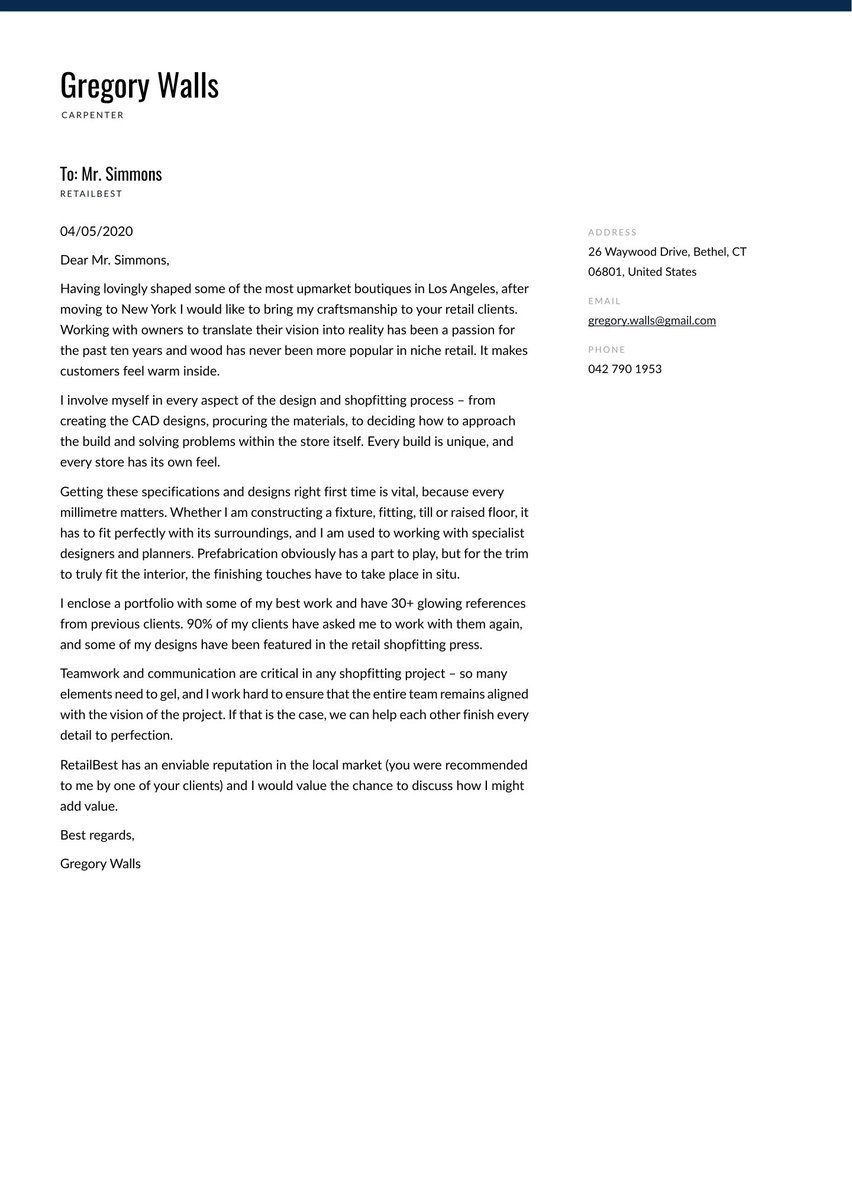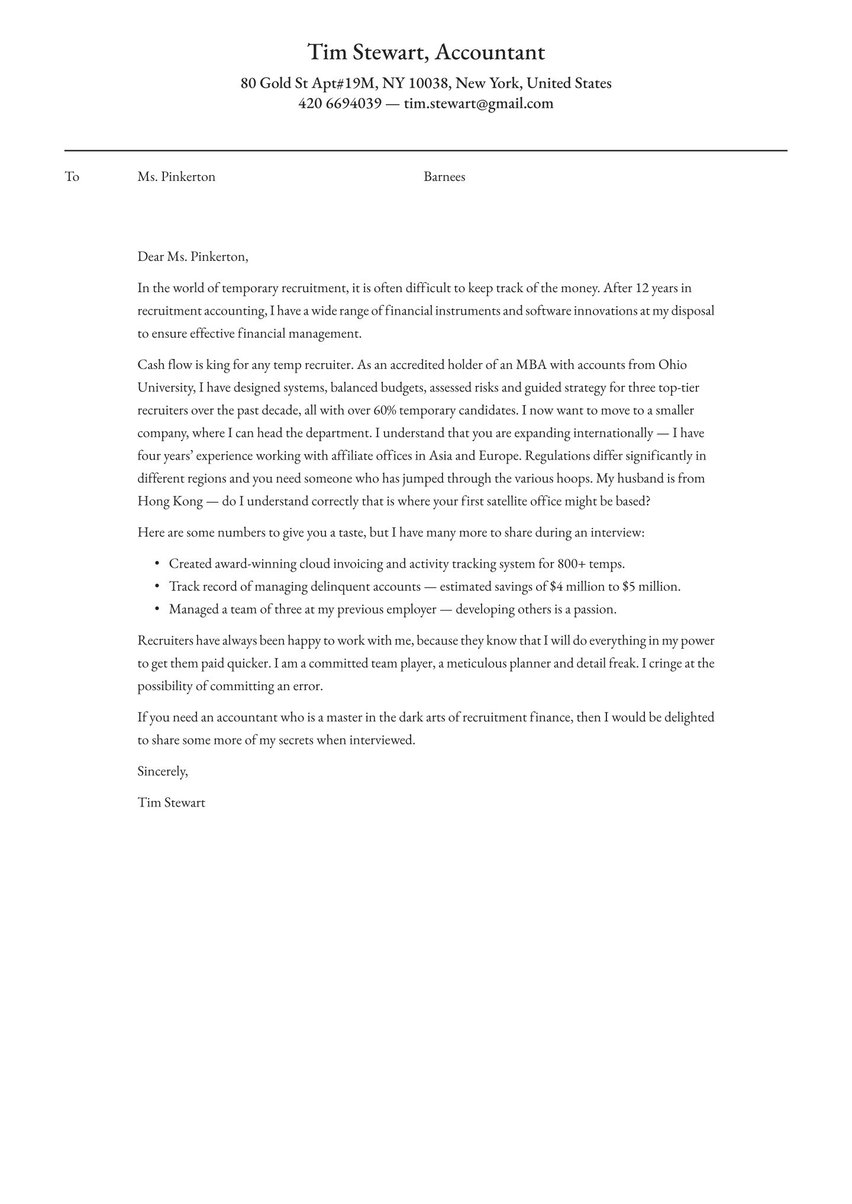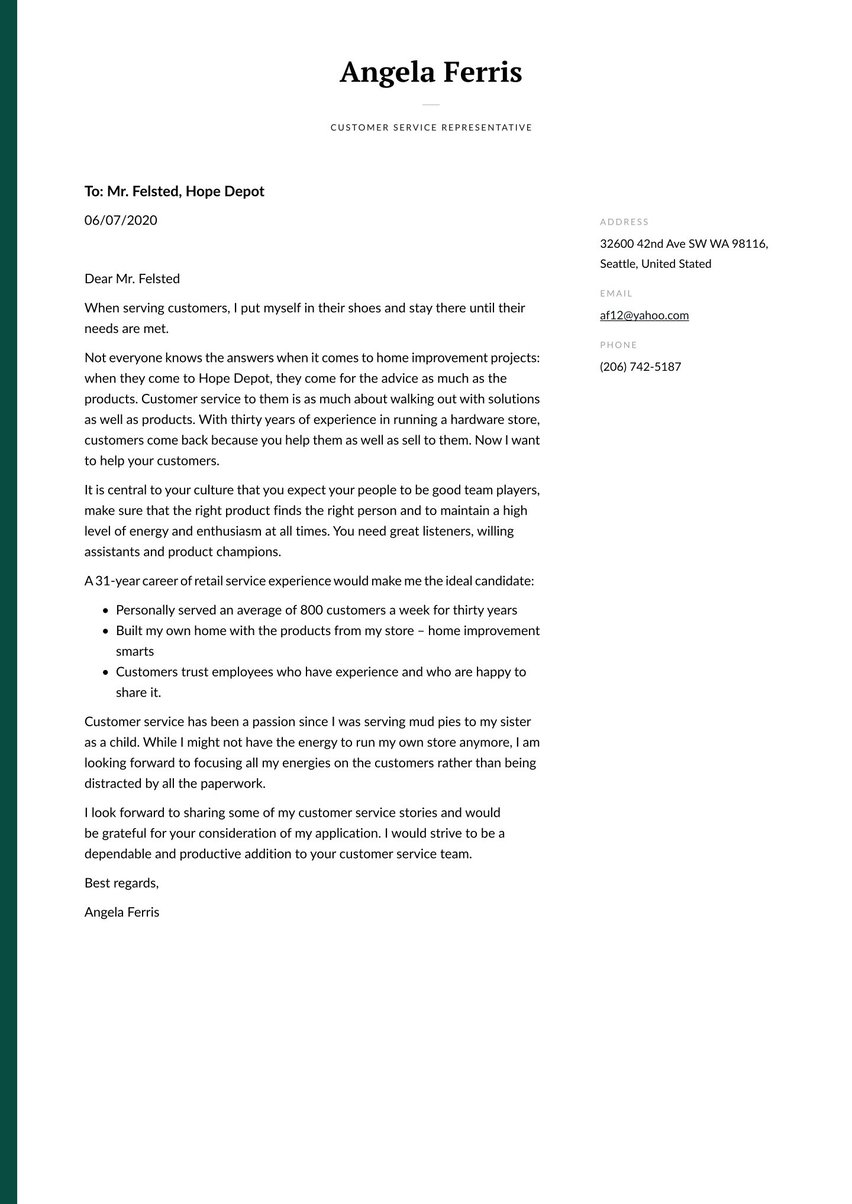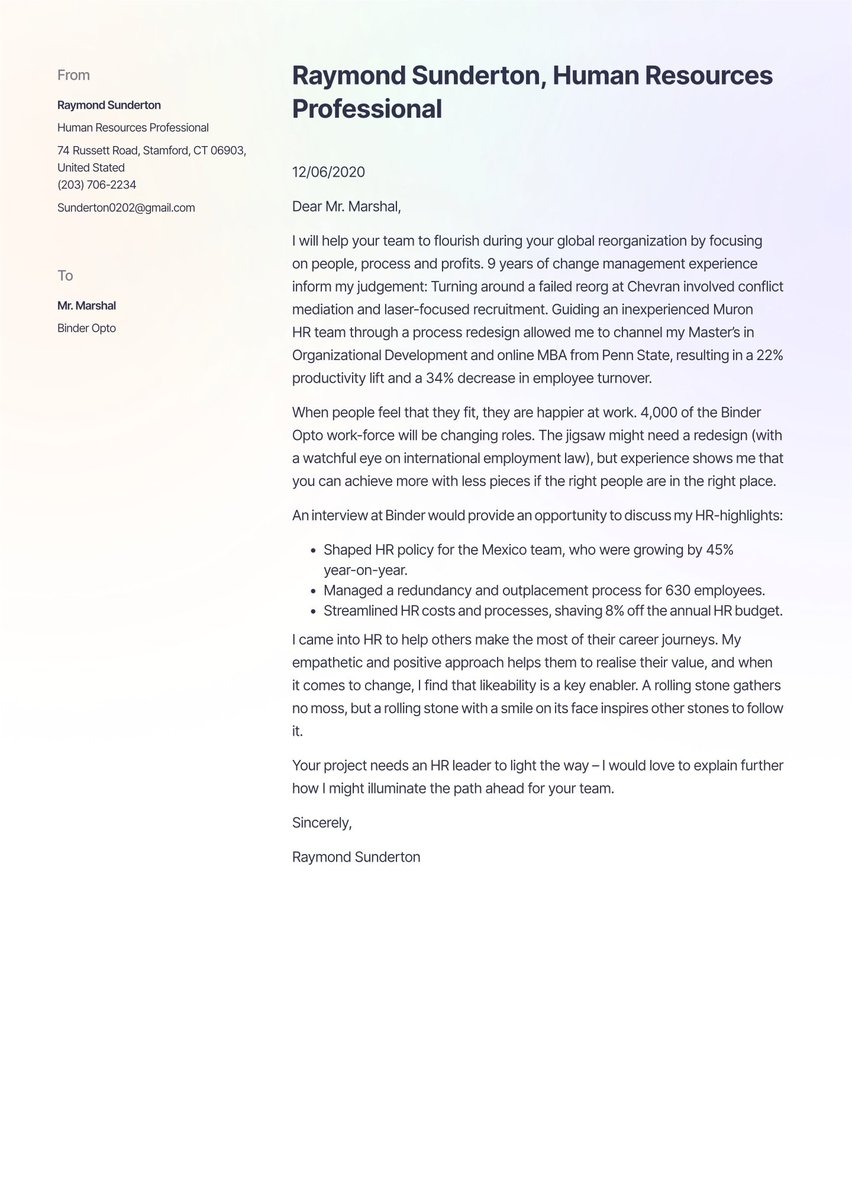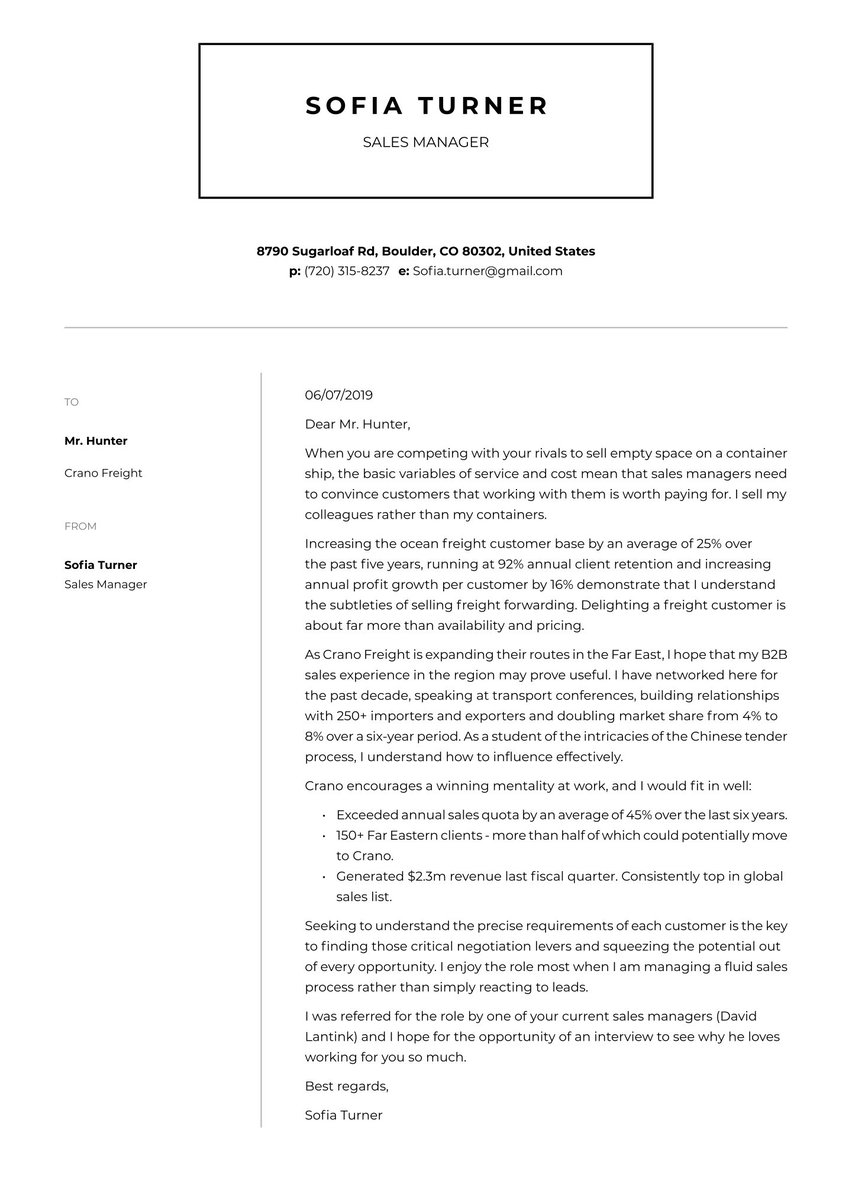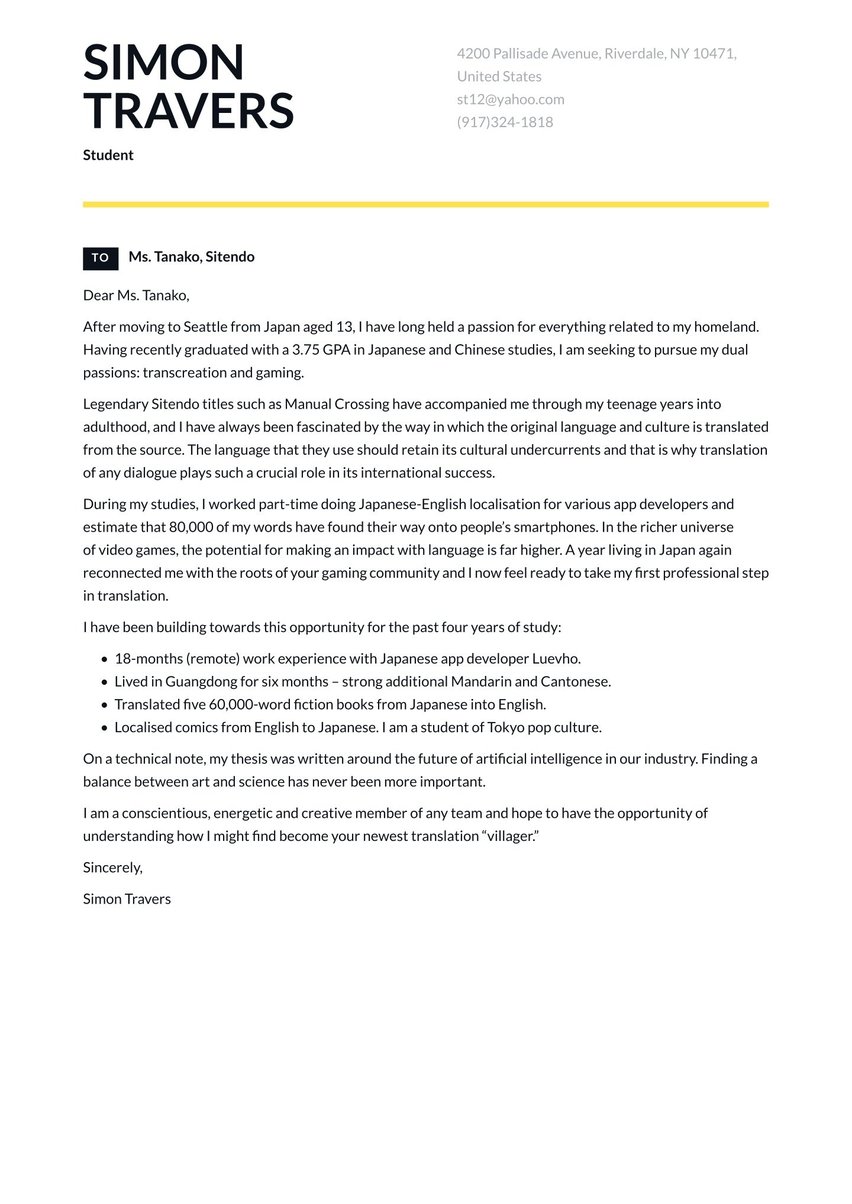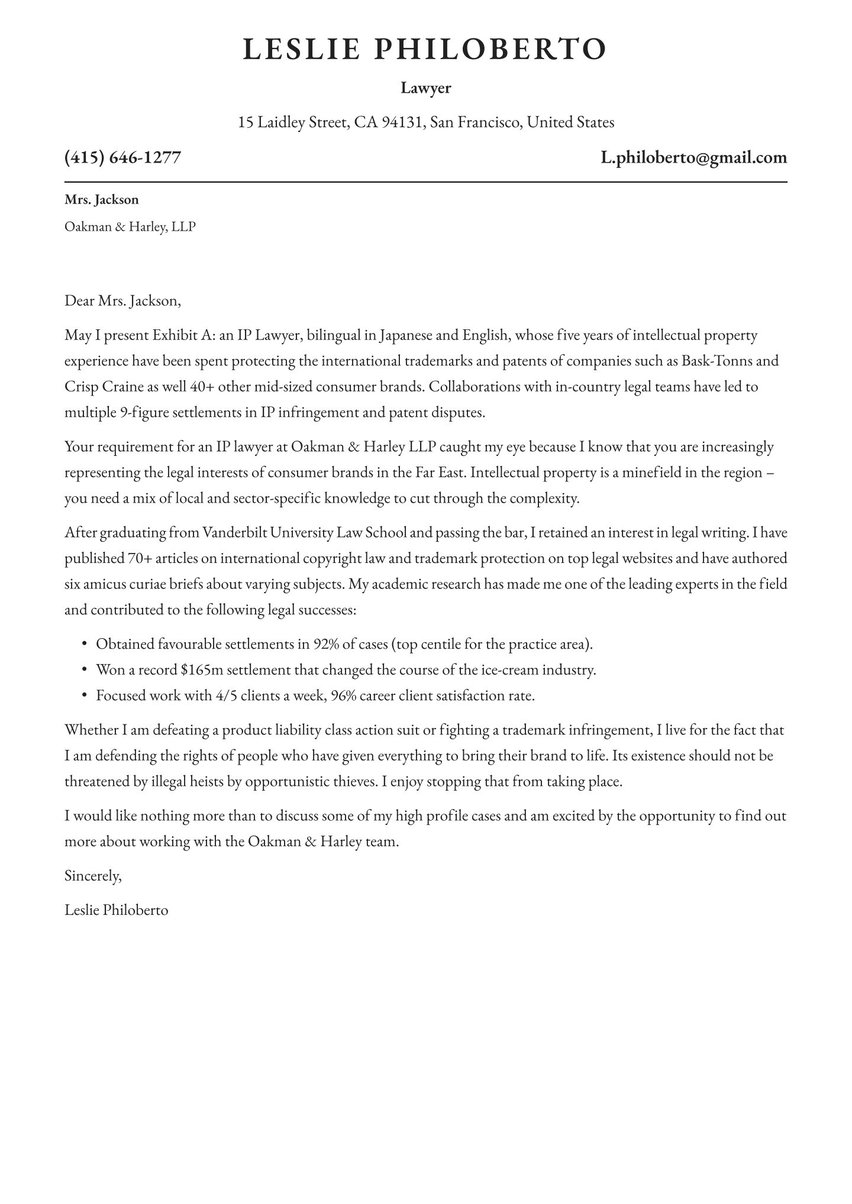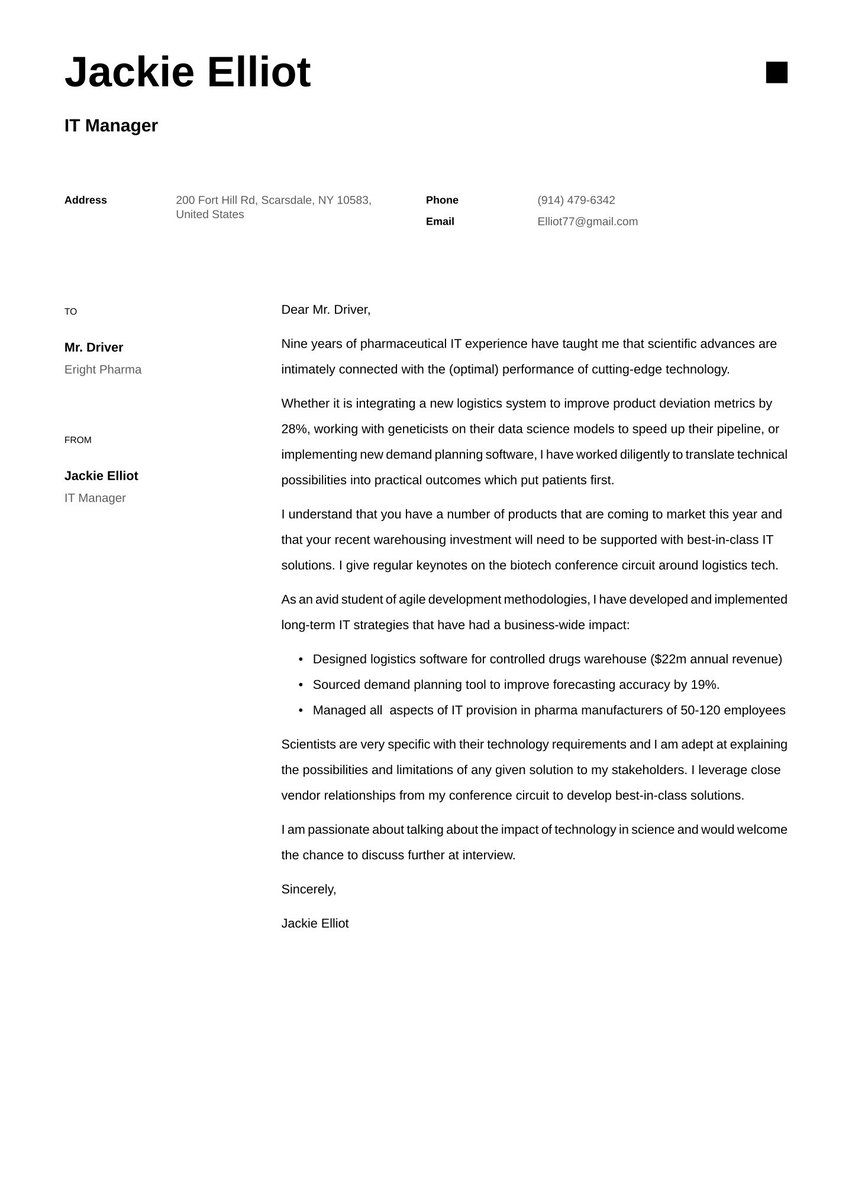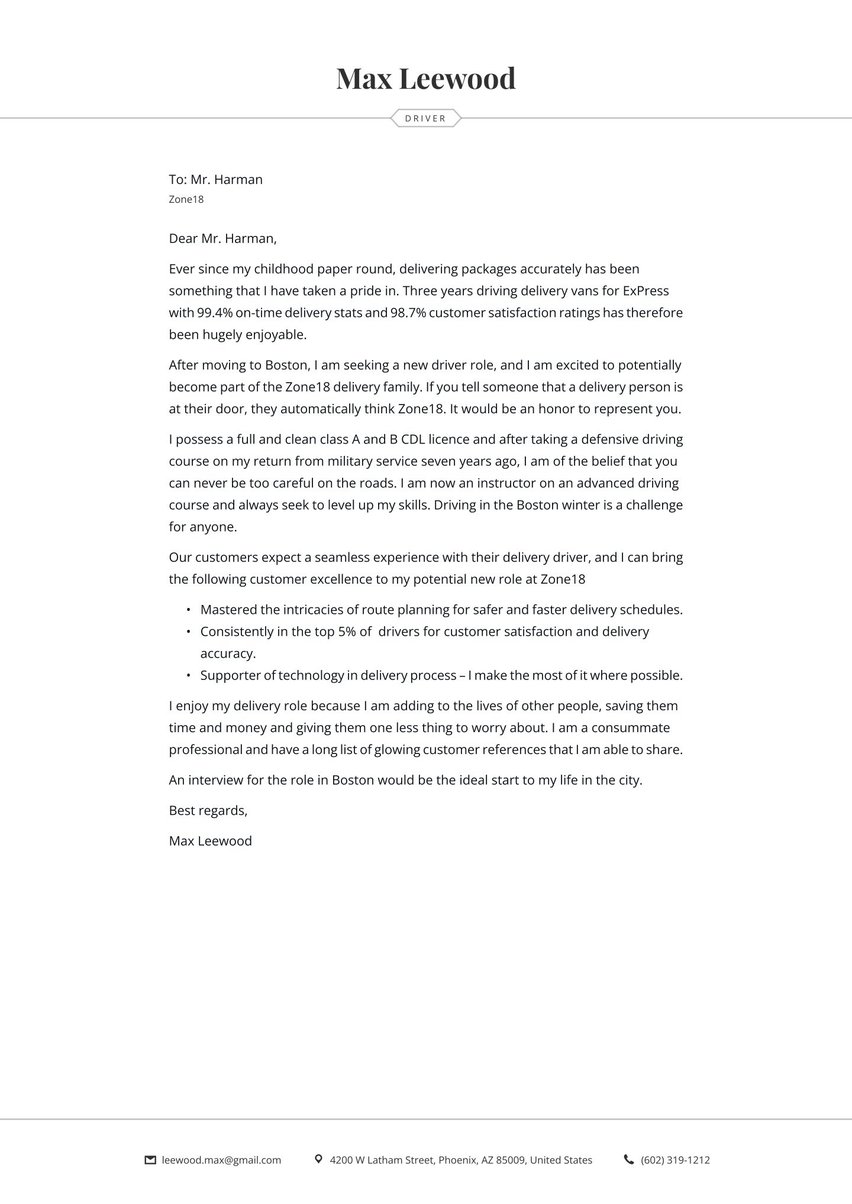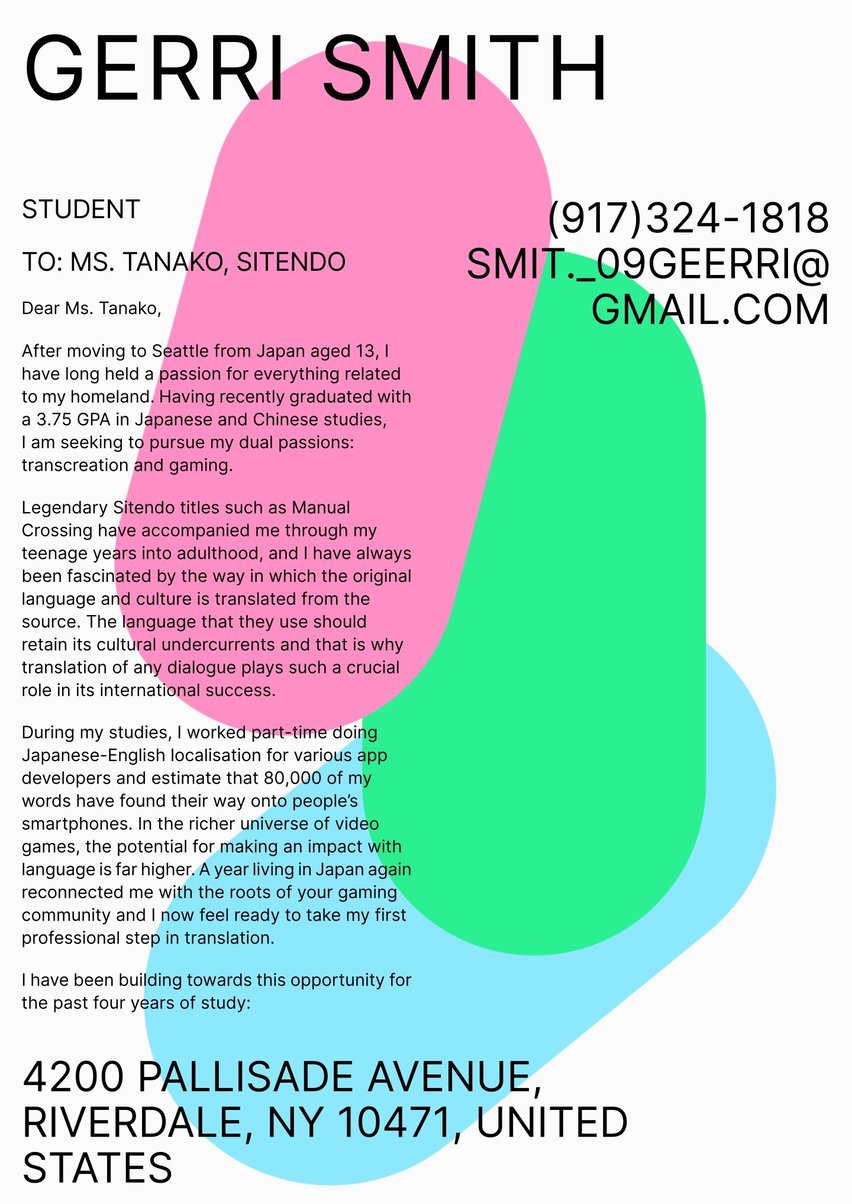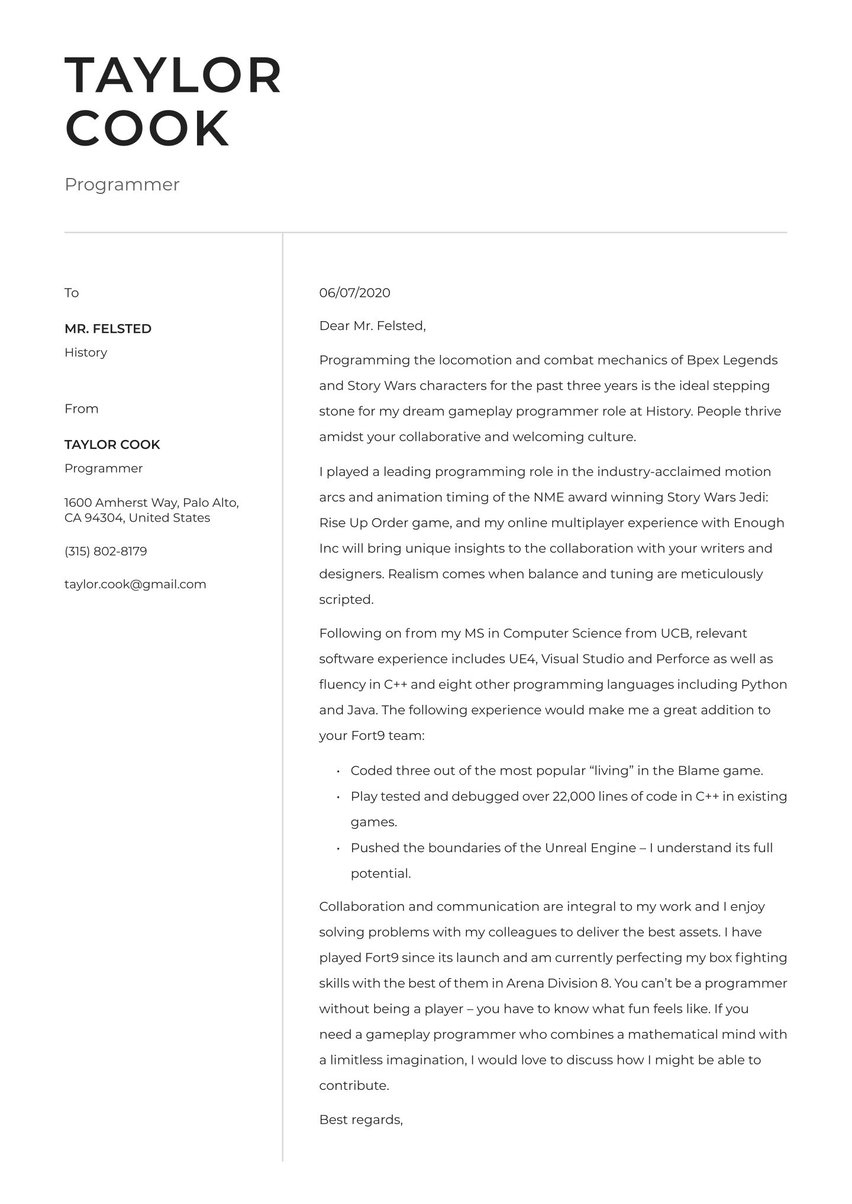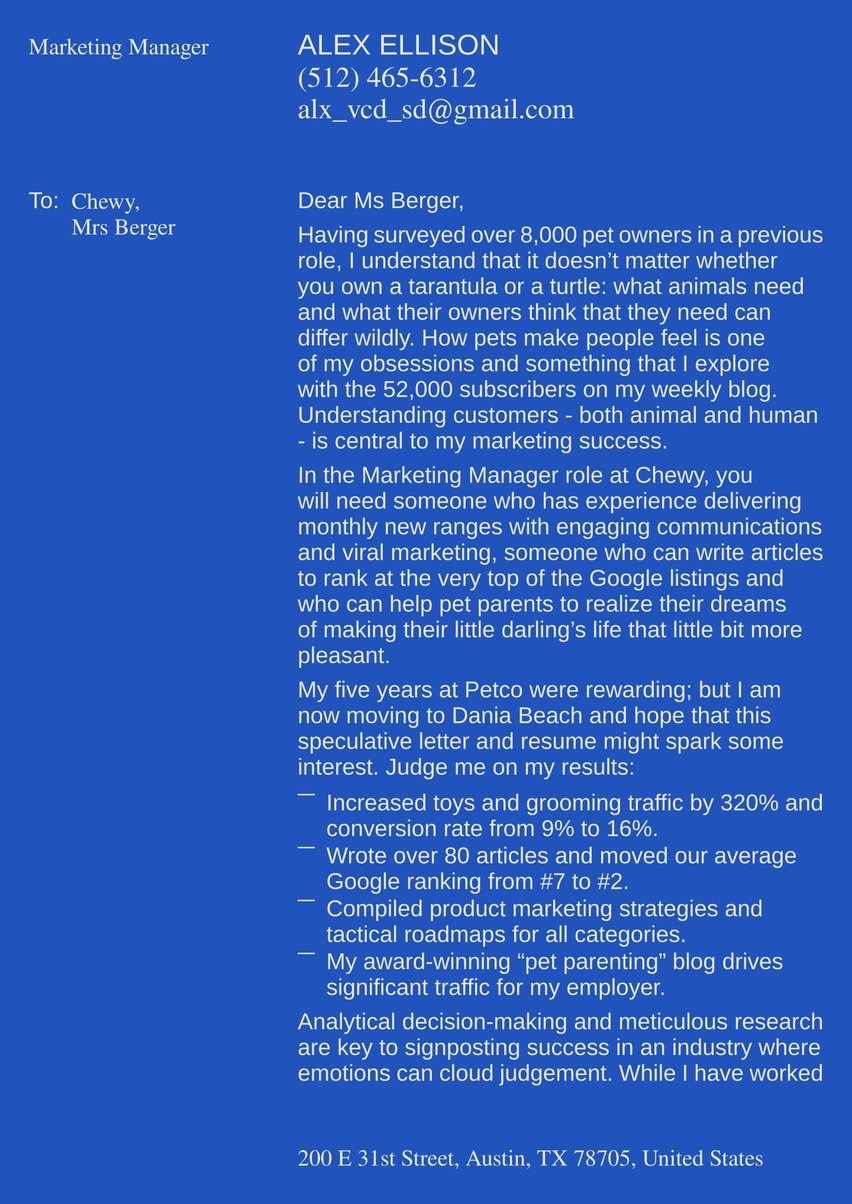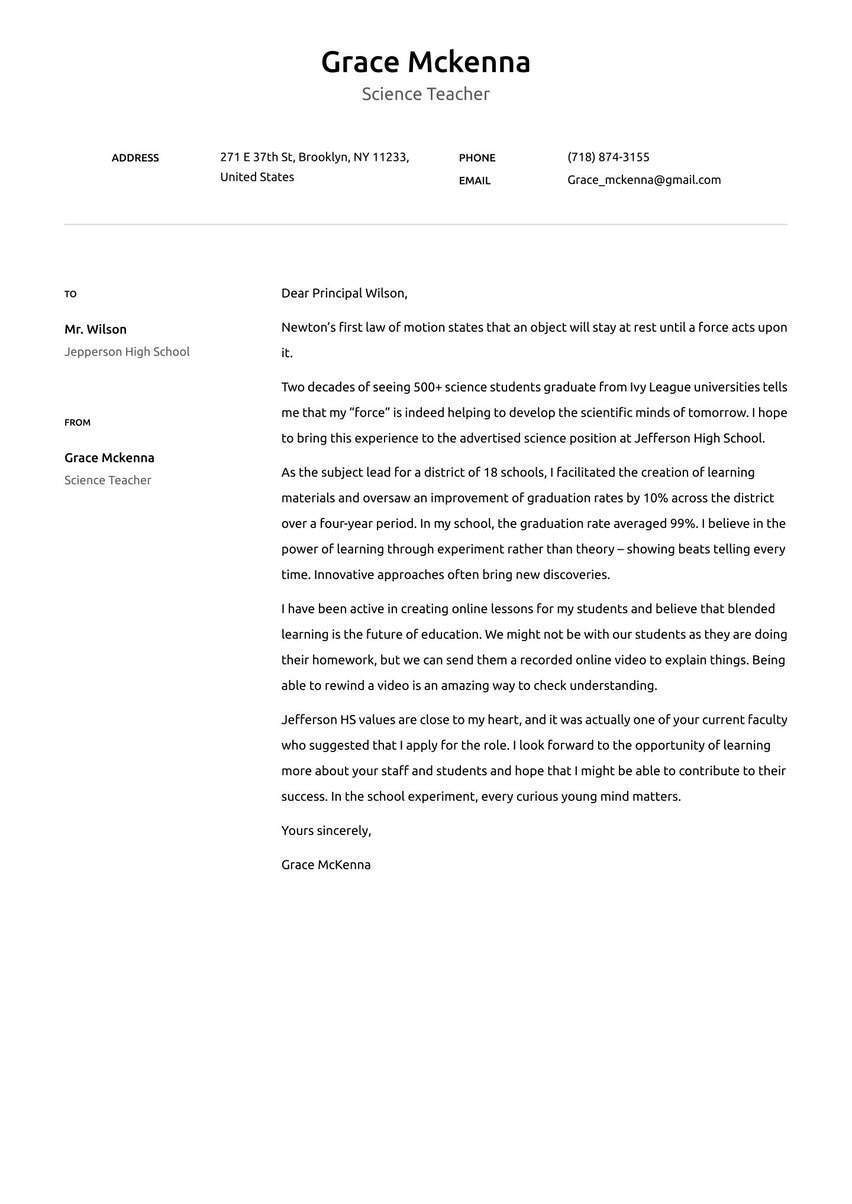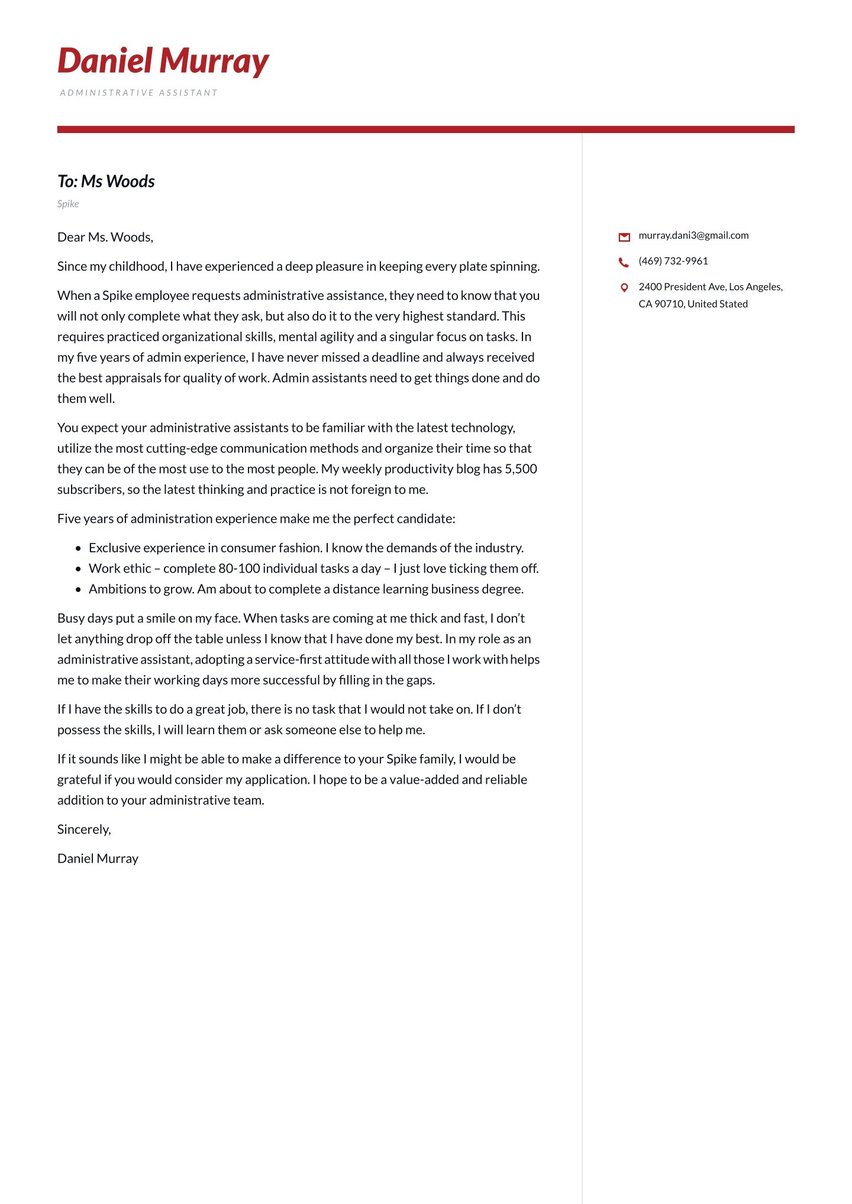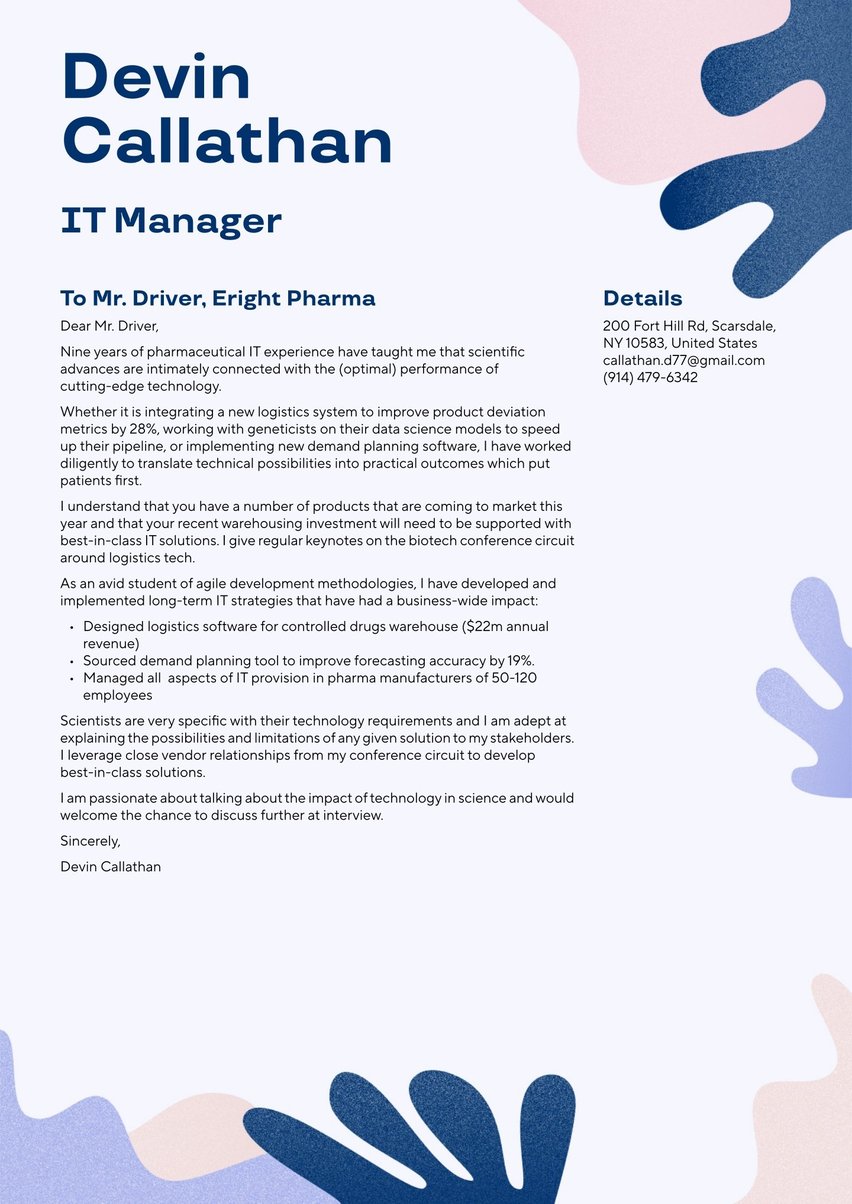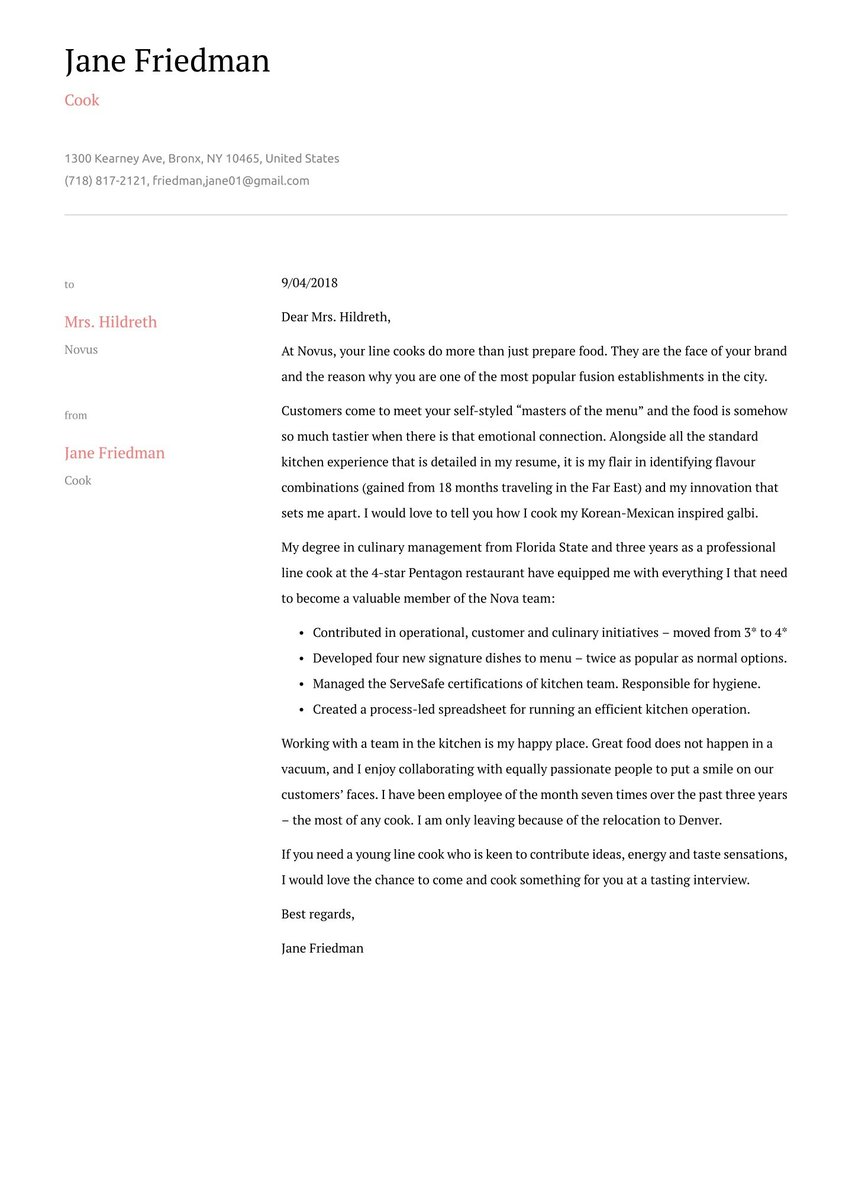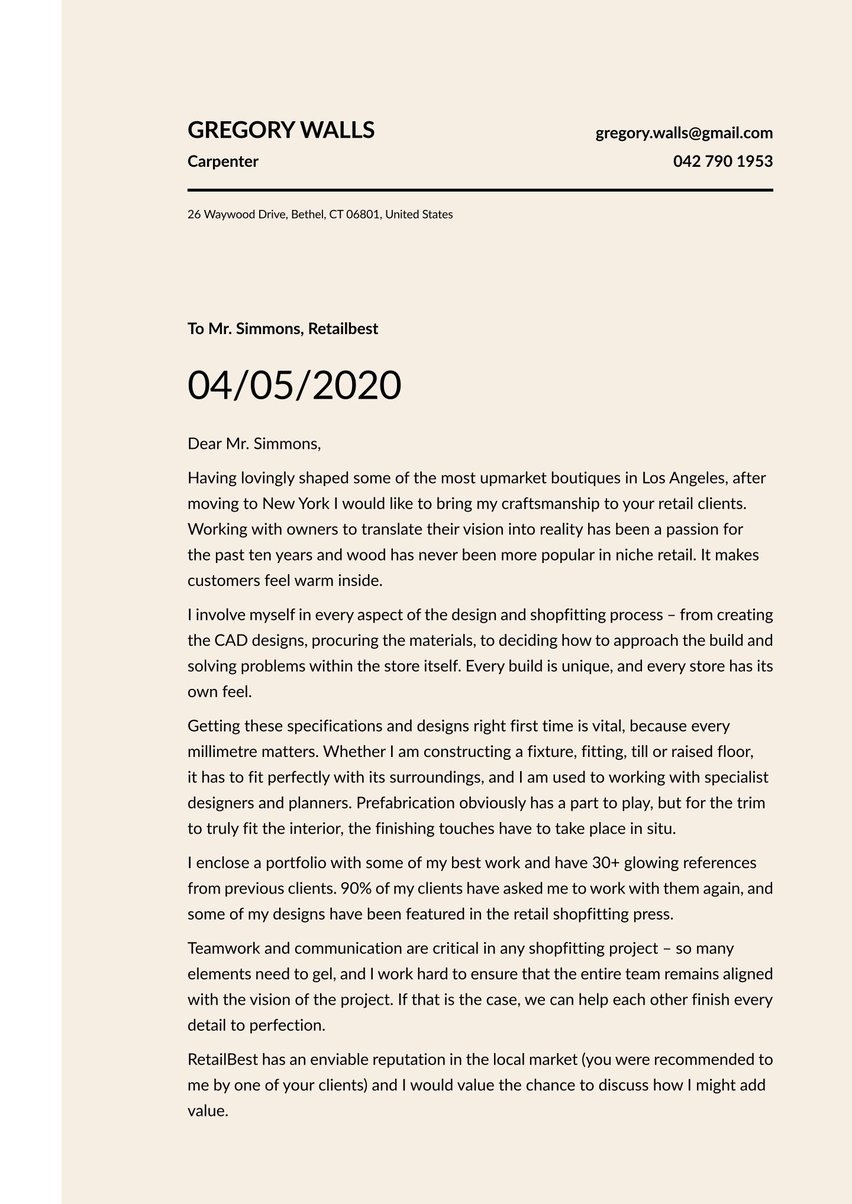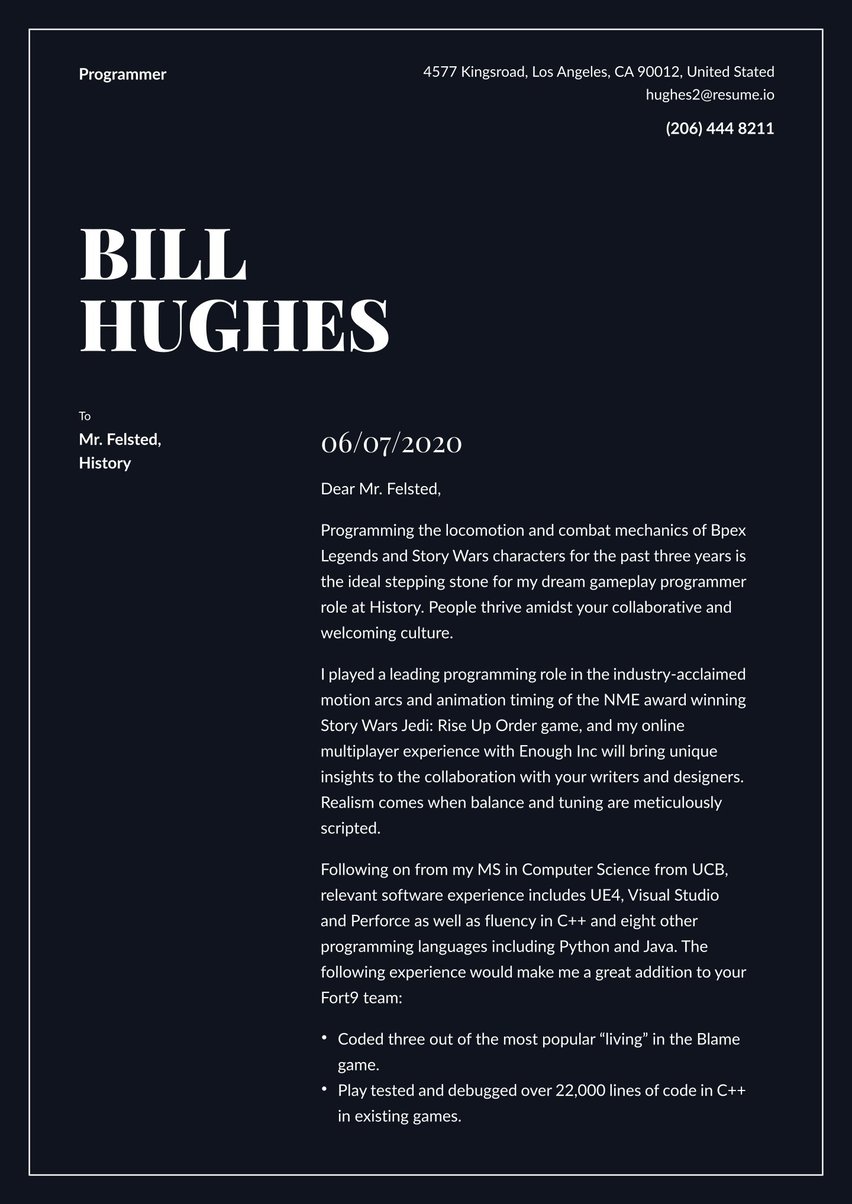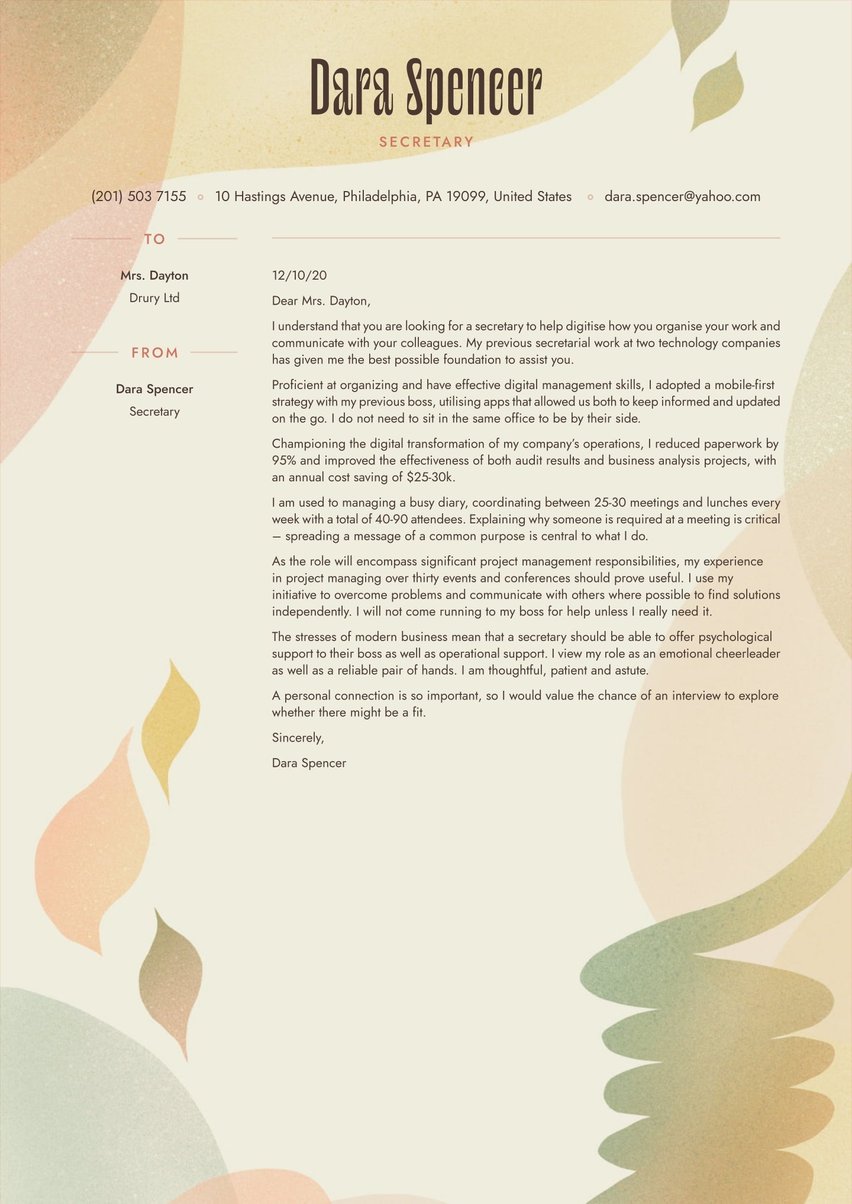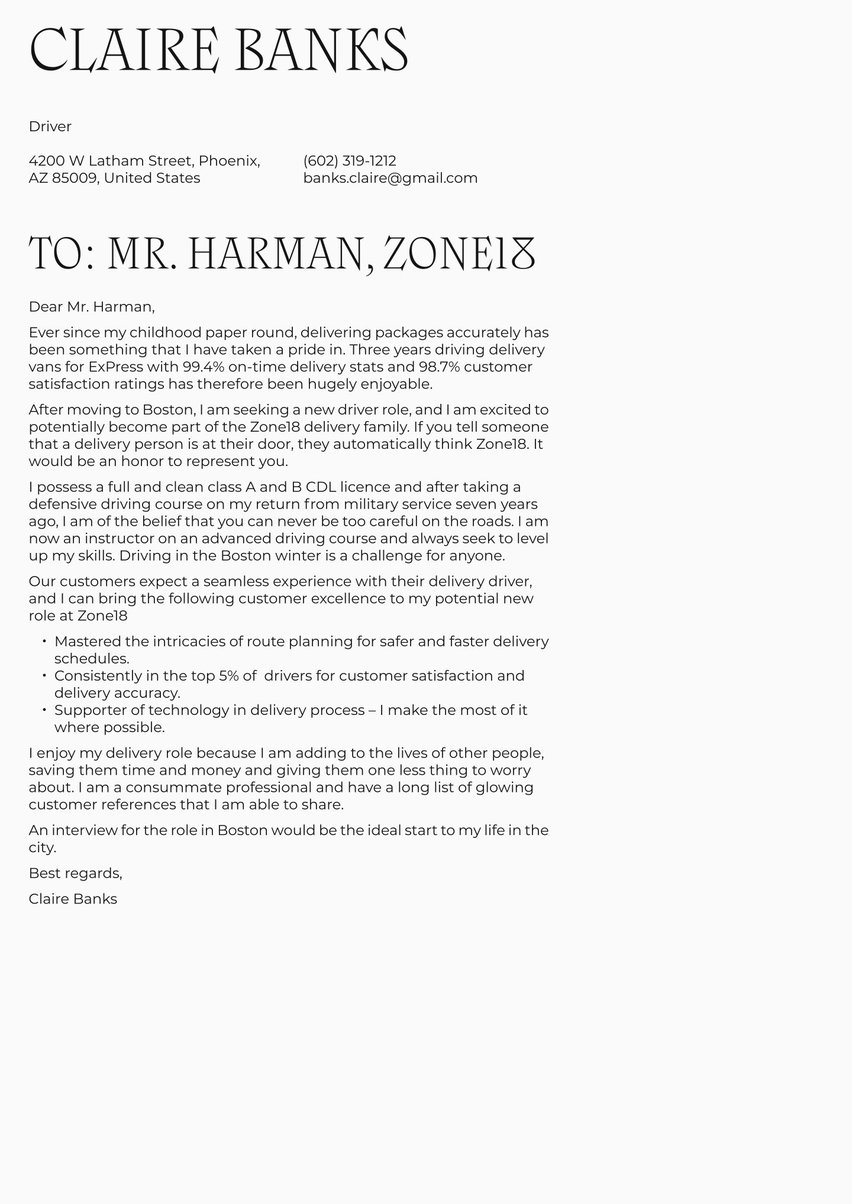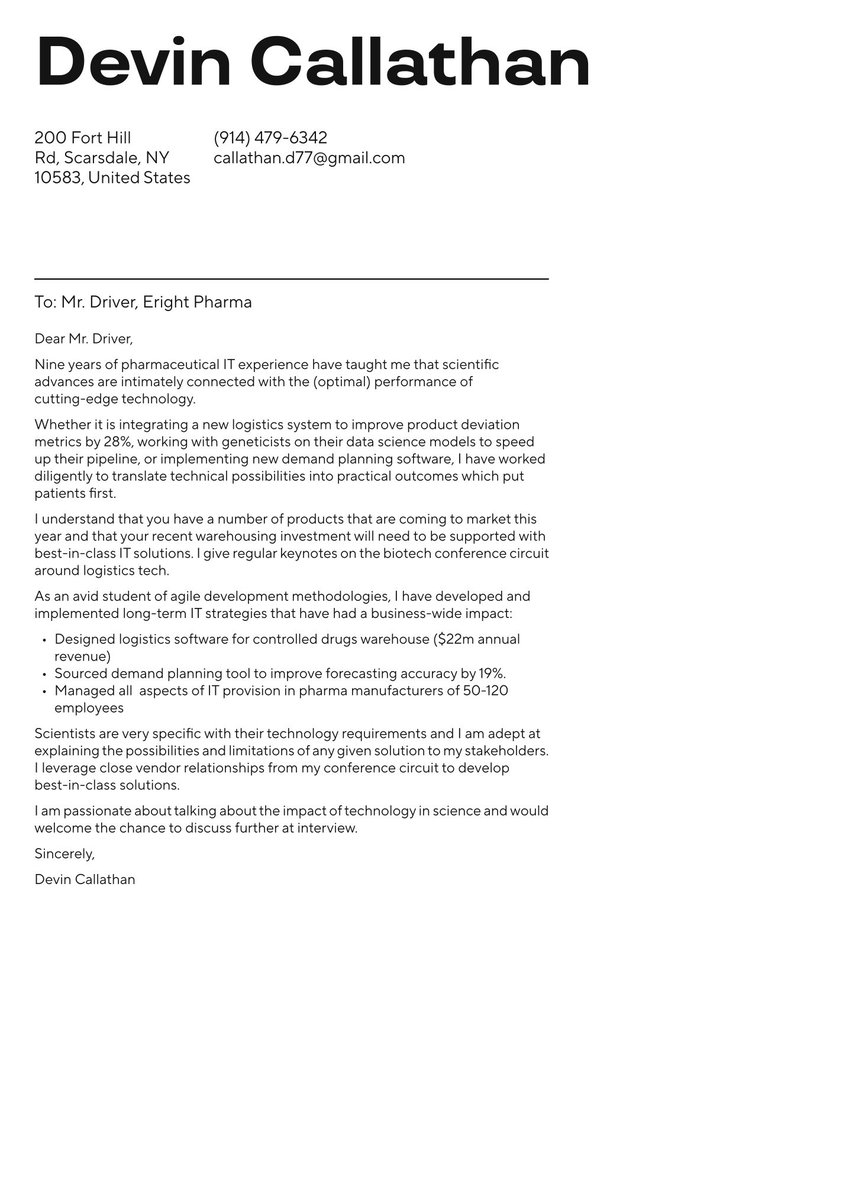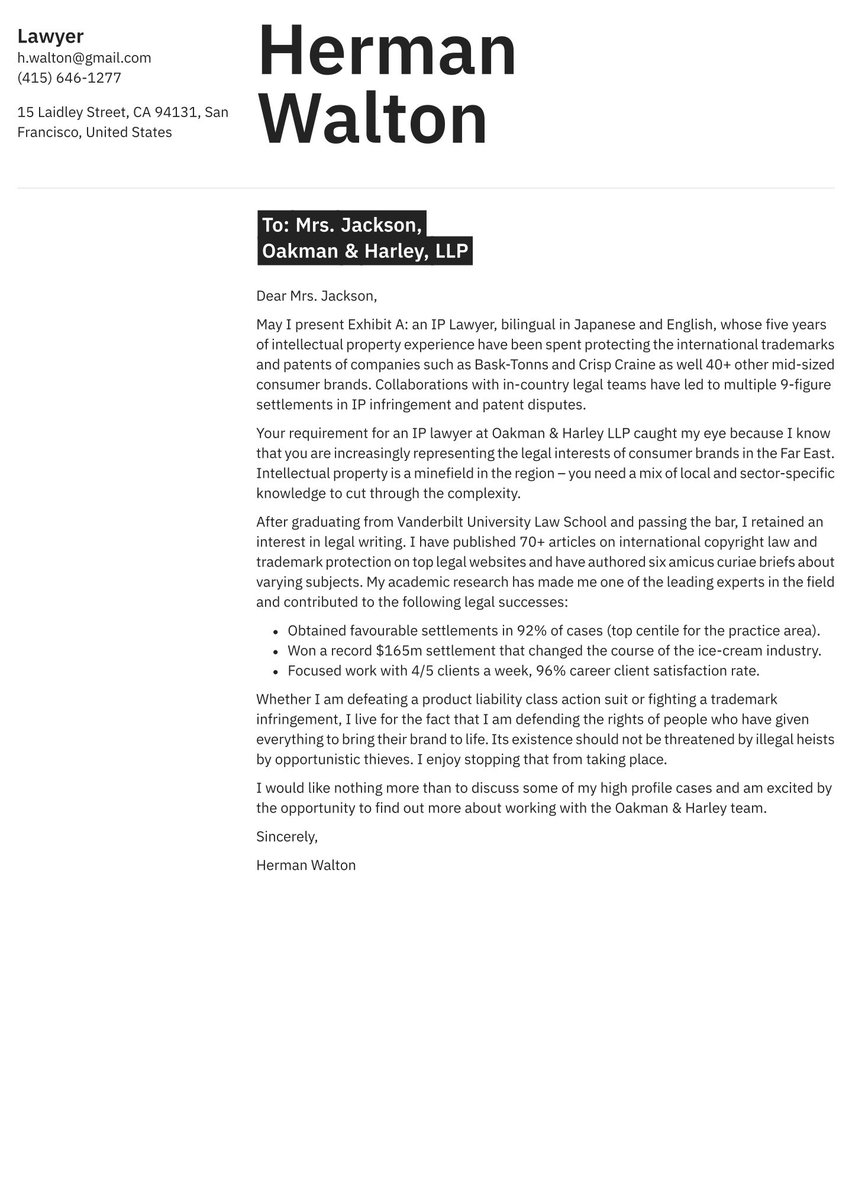Ah, the irony of writing a recruiter cover letter. Normally you’re the gatekeeper that all candidates struggle to impress. Now, you’re the one knocking at the door, hoping the hiring manager on the other side will have time to read all about your recruiting strategies and retention rate.
Not only does a cover letter for a recruiter have to convey your most impressive skills and excellent hiring track-record, it also has to serve as an example of what the perfect cover letter looks and sounds like. You won’t be trusted to evaluate new hires’ applications without first proving that you can ace the process yourself.
It might seem like a lot of pressure, but you got this! Your cover letter is the perfect place to highlight your in-depth knowledge of the hiring process and your strategies for bringing the best candidates to work for your potential employer.
Resume.io’s tips, tools and resources are right by your side to help you make sure your application is flawless. That includes a wide selection of occupation-specific cover letter examples and guides on how to write them, in addition to resume guides and samples.
This writing guide, along with the corresponding recruiter cover letter example, example, will:
- Show you the importance of a cover letter how to overcome the unique challenges recruiters face when writing one
- Review the best format for structuring a cover letter
- Offer advice for each cover letter section: header, greeting, introduction, body and closingOffer free examples, samples and templates to help you model the perfect document
- Look at writing psychology
- Explore the secrets of landing your first recruiter position with no experience
- Help your application stand out from other candidates, impress the employer and win the job!
Why you need a cover letter
Primary purpose
As a recruiter, you’ve read hundreds — maybe thousands — of cover letters. You’ve seen the good, bad and downright ugly. Yet stopping to actively evaluate your own skills and accomplishments can be surprisingly difficult. This recruiter cover letter example is designed to break down the process into manageable steps so you can be sure you’ve checked all the right boxes.
Even if you have years of experience in human resources, there’s no reason why a cover letter should ever be longer than one page (about 200 to 400 words). Choose a handful of concise, clear examples of your achievements and top contributions to previous positions and focus on those throughout your cover letter.
Don’t forget to bring your personality and human side to your cover letter. HR managers get a bad rap for being the no-fun, always-by-the-book employees. Use your cover letter to make a personal connection and share information not found on your resume. You should also establish an authentic link to your interest in the industry and your company’s activities.
Do I really NEED a cover letter?
You’ve probably met recruiters who didn’t read cover letters – maybe you were one yourself. You may be wondering why you should waste time carefully crafting this document if it’s only your resume that counts. This predicament can be made worse by the fact that online job applications sometimes list a cover letter as “optional.”
Before you give up on a cover letter, consider this: in an office full of hiring managers, what makes you stand out? If another recruiter had your same work history, how much different would their resume be? If the answer is “not much,” then it’s worth writing a cover letter. For hiring managers who read them, these documents give key insight into who meshes well with the company and whose approach to recruiting will yield the best results. A cover letter is a key opportunity to make a great first impression – don’t pass it up! Remember: getting hired is a game of increasing your chances and numbers.
Visual presentation is one of the first aspects a recruiter takes in when they look at a cover letter. Your document should be polished, professional and customized for the company’s tone and industry. You can get dozens of tips, including the most attractive fonts, in our guide to formatting a cover letter.
Secondary purpose
When written with care, a cover letter is all about setting yourself apart from other qualified candidates and maximizing your chances of landing the position. A resume is great for bullet point achievements, but it doesn’t give an HR team the chance to get to know you. What do you look for in a successful candidate? How do you evaluate someone in an interview? How well do you understand what makes a successful employee in this industry?
As a recruiter, you shape the company’s future. Your cover letter is the place to demonstrate a clear understanding of staffing needs, the future of the industry and the talent acquisition process. Your tone and word choice should convey confidence, a team spirit and a sense of purpose.
Customizing your cover letter for success
Any business that needs employees, needs at least one recruiter. That means HR staff works in every single industry that exists. While you don’t need to be an expert in the company’s exact operations, an understanding and interest in what the company actually does is key to proving you’d hire the right employees and make a great fit.
While you can keep your brightest hiring achievements on most of the cover letters you send out, it can pay off big time to tailor at least one paragraph with a specific statement or connection to the company you’re applying to. Make sure to explain why you want to work for them instead of just resting on your previous accomplishments.
For more ideas and inspiration, check out these related writing guides and cover letter examples in our Human Resources category:
Best format for a recruiter cover letter
Cover letter writing can feel daunting because the document doesn’t quite have the measured sections that a resume does. That doesn’t mean it’s completely structureless, however. In the following section, we’ll break down the writing process into manageable steps that can be used in any industry. Here are the key components:
- The cover letter header
- The greeting / salutation
- The cover letter intro
- The middle paragraphs (body of the letter)
- The ending paragraph of your cover letter (conclusion and call-to-action)
Let's take a closer look at each section.
05/10/23
Dear Ms. Beckenham,
Having topped the billing list at Harding & Dalkeith, averaging $350,000 in annual revenue during my time there, I am writing to see how my extensive network of sales leaders might help you to grow the recruitment desk in your New York office.
I have long heard about your expansion plans, and if you entrust me with the acceleration of the sales function, I can promise you a warm list of blue-chip clients who are crying out for talent. I have made 100+ placements over the past six years, and every placement is now an active part of my personal referral network. Taking care of people is a crucial pillar of your brand ethos, and I ensure that I nurture every relationship.
Specializing in both B2B and consumer markets, I generally work on Director-level roles in 1,000+ employee companies. Enterprise sales is an area where my reputation is solid – when the difference between the wrong and right hire can be counted in the millions of dollars, you have to be able to trust your recruiter and know that they will persevere to find the right match.
Sales-specific social media groups provide me with most of my candidates and job leads, and I regularly contribute to people-related sales podcasts and online conferences. If you are visible, you are trusted. My 16,000 personal connections on LinkedIn have grown at a rate of 20% a year, and I helped my previous employer to increase website hits by 45% and sales-specific job applications by 32%.
I used to work with your Technology Team Leader, Travis Chase, and he has convinced me that I would fit in with your driven and high-achieving culture. I enclose multiple references from former clients and candidates and would be delighted to discuss further at interview.
Sincerely,
Frank Bishop
Cover letter header
First up, let's deal with the cover letter header. As a recruiter, you know how frustrating it is when someone’s cover letter isn’t properly labeled. Avoid the same mistake on your own document by creating a cover letter header that contains just the right amount of personal information like your name, email address and phone number. Your future HR team will thank you for giving them an easy way to get in touch!
The second purpose of your header is to create a clean and attractive presentation. Make sure to evaluate the company’s branding and image before deciding how much color (if any) to use. Since HR is a fairly formal field, you’ll want to walk the line between straightforward professionalism and a touch of flair to make you stand out from other applicants.
The goal of this section: Keep your contact information at the hiring manager’s fingertips so they can easily contact you for an interview, create an interesting and professional format that aligns with the company image
Align document styles!
One of the easiest ways to make a statement is by aligning the document styles of your cover letter and resume. This simple step allows you to craft a personal brand – a look and feel that defines your application and makes you memorable in a hiring manager’s mind.
If you haven’t yet honed your graphic design skills, you may consider using a resume or cover letter template. Just be sure to adapt it to suit the company’s branding and your own personal style so that your application is uniquely your own. You can find plenty of template options in Resume.io’s Professional collection.
Cover letter greeting
Get the greeting right and you’ll boost your chances of keeping the reader throughout your entire letter. Make sure to choose a respectful and friendly greeting that’s also appropriate for the workplace culture. While “Dear” is the traditional option, many casual companies would find “Hello” or “Hi” to be perfectly acceptable, especially if your cover letter is submitted by email. As always, address the letter recipient by name whenever possible.
The goal of this section: Use the most appropriate greeting for the workplace environment to create a personal connection and respectful tone, use the letter recipient’s name
The importance of names and addressed greetings
Making a personal connection is one of the best ways to make sure your cover letter gets noticed. Nowhere is this more important than in the cover letter greeting. It’s been scientifically proven that humans have a positive neurological response to hearing their own names – but you don’t need science to understand that an applicant who uses the correct hiring manager’s name is clearly serious about the position.
Unfortunately, in today’s hiring environment, it can be near-impossible to find the name of someone in a large HR team, let alone know exactly who or how many people will be reading your letter. If you really can’t narrow it down to one or a few people, you can opt for a general greeting as the last resort. “Dear (Company Name) Hiring Team” or “(Company Name) Recruiting Manager” can be solid options. In any case, try to avoid the cold and outdated “To Whom It May Concern.”
Cover letter introduction
If you’ve worked in human resources before, you know that recruiters only have a few minutes – sometimes even less – to evaluate each application. That’s why it’s so important that your introduction makes a statement and sets you apart – especially when many other applicants are going to have similar work experiences to draw from. A bold personal statement, relevant statistic or interesting anecdote can all serve to pull a hiring manager into your cover letter.
The goal of this section: Use a fact, statistic or statement to create an attention-grabbing opening paragraph that sets you apart and immediately leads into the body section.
Dear Ms. Beckenham,
Having topped the billing list at Harding & Dalkeith, averaging $350,000 in annual revenue during my time there, I am writing to see how my extensive network of sales leaders might help you to grow the recruitment desk in your New York office.
Cover letter middle part (body)
The middle paragraphs of cover letters are arguably the most important. Your cover letter body is where you can finally dive into all the skills, accomplishments and strategies that make you stand out as a recruiter. The STAR method can be useful. First, list a Situation, then the Task, your Action and the positive Result. For a recruiter position, make sure to choose the most relevant situations for the type of hiring you’ll be doing for your potential employer.
You’ll also want to research the hiring organization and the industry, especially if it differs from your previous experience. Make sure to convey your potential contributions and a connection to the field, which can help show how you understand their specific hiring needs.
The goal of this section: Offer examples of previous hiring successes or other accomplishments via the STAR method, create a connection to the field and offer potential contributions to highlight how you’d fit in at the company.
I have long heard about your expansion plans, and if you entrust me with the acceleration of the sales function, I can promise you a warm list of blue-chip clients who are crying out for talent. I have made 100+ placements over the past six years, and every placement is now an active part of my personal referral network. Taking care of people is a crucial pillar of your brand ethos, and I ensure that I nurture every relationship.
Specializing in both B2B and consumer markets, I generally work on Director-level roles in 1,000+ employee companies. Enterprise sales is an area where my reputation is solid – when the difference between the wrong and right hire can be counted in the millions of dollars, you have to be able to trust your recruiter and know that they will persevere to find the right match.
Sales-specific social media groups provide me with most of my candidates and job leads, and I regularly contribute to people-related sales podcasts and online conferences. If you are visible, you are trusted. My 16,000 personal connections on LinkedIn have grown at a rate of 20% a year, and I helped my previous employer to increase website hits by 45% and sales-specific job applications by 32%.
How to close a recruiter cover letter (conclusion and sign-off)
Finish your cover letter with a sincere and positive call to action. Tell the hiring manager how interested you are in the position and invite them to contact you for an interview. You may also choose to leave your contact information again here.
Then finish your letter with a respectful sign-off phrase which matches the tone of your greeting and the company. “Sincerely” or “Best regards” are great, professional options.
The goal of this section: Create an effective Call to Action that leaves a hiring manager wanting to learn more about you and get in touch, then finish the letter with a polite sign-off / closing line.
I used to work with your Technology Team Leader, Travis Chase, and he has convinced me that I would fit in with your driven and high-achieving culture. I enclose multiple references from former clients and candidates and would be delighted to discuss further at interview.
Sincerely,
Frank Bishop
Writing psychology — cover letter tools and strategies
For a recruiter, there are a few key qualities you’ll want to convey, especially if you’ve never worked in the HR field before.
- Professional communication: You are the first contact a candidate will have with the company. As such, your ability to communicate in a clear, concise and friendly manner will set the tone for the rest of the interaction and help a candidate decide if they will accept the job offer. Your cover letter should contain professional word choice and perfect grammar and spelling.
- Organization: Recruiters juggle a lot of applications, paperwork and processes at the same time. One mistake could spell a big embarrassment for the company. Make sure to highlight your attention to detail and penchant for multitasking in your cover letter examples.
- Modern recruitment techniques: Recruitment is no longer about throwing the line out and seeing which candidates bite. You must actively search for the best talent in industries where there are more openings than qualified applicants. Understanding marketing, data research and online candidate sourcing and onboarding are a must.
- Relationship building: Strong, professional connections are at the heart of everything a recruiter does. You’ll need to have finely-tuned listening skills, negotiation abilities and a charisma that makes a candidate excited to take the job offer. Demonstrate these qualities in the tone of your cover letter.
Recruiter cover letter with no experience
“Recruitment” isn’t a college major, and you won’t find many 10-year-olds who dream of growing up to become a recruiter. Almost everyone who works in HR studied something else or started in another field before finding out that they had a knack for recruiting. That means there’s plenty of opportunity for you to enter the field even if you don’t have any experience in it yet. A lot of other industries can prepare you for the type of work recruiters do every day.
So how do you land your first job as a recruiter if you’re coming from another background? Your cover letter gives you the space to discuss transferable skills and the reasons why you think you’d be perfect for the position. Here are some common industries that can help you make the jump to recruiting:
- Sales: Modern recruiting is about selling a company’s opportunities and advantages to the best candidates. A sales background shows you know how to make cold calls, personal connections and highlight the reasons why the best candidates should join your team.
- Customer service: Recruiters need top-notch professional communication skills and if your job is more of an HR generalist, you’ll also need to diplomatically handle issues while still protecting the company image. Customer service teaches you to win over people you don’t know and can help you become an expert interviewer.
- IT/Tech: While most candidates think recruiters always have the upper hand, in fact, recruiters can sometimes struggle to find exactly the right applicants to fill their openings. Recruitment is an active role which requires data, software and strategy to reel in the best of the best. An IT or tech background can quickly help you assert yourself as a recruiter for the modern age.
Another way to get the foot in the door of your first recruiting position is to apply to an industry where you previously worked in another capacity. No one understands what a newsroom needs in its next news producer like a former reporter themselves. Sell yourself as a candidate who gets the industry from experience and knows exactly what type of candidates will drive the business forward. This works especially well in close-knit fields or ones requiring specific industry knowledge.
Leverage social media to your advantage
Even if you’ve never worked as a recruiter before, you’ll still need to create a near-perfect cover letter and resume to prove you understand the hiring process. Another area you won’t want to overlook is your social media presence. LinkedIn is an invaluable tool for modern recruitment and you’ll want to make sure yours is in tip-top shape. Check out our guide on how to craft the perfect LinkedIn profile and make sure to include your profile in your cover letter header.
Common mistakes to avoid in your recruiter cover letter
As an applicant to a recruiter position, a single cover letter error could ruin your chances of landing the position in a snap. Avoid these common pitfalls to prove you understand what makes a great applicant.
- Spelling or grammar mistakes: The smallest typo could immediately ruin your credibility and make a hiring manager believe you lack attention to detail. Spell check as often as needed and ask a friend to proofread your application before you hand it in. Better yet - entrust this to specially designed software features (such our resume builder’s spell-checker).
- The wrong tone: Modern workplaces are increasingly favorable to more casual communication. Writing a prim and proper letter to a company that values an innovative approach shows that you just don’t get the employer. Likewise, a traditional office is easily turned off by a candidate who doesn’t exhibit the right level of professionalism.
- Generic examples: If you have recruitment experience already, it can feel like a breeze to submit practically the same letter to each position. However, candidates that can prove their ability to hire the best talent in a specific industry will likely fare far better in landing an interview.
- Poor formatting: Don’t let spacing issues, unprofessional fonts or inappropriate color choice ruin great writing. There’s nothing wrong with professional help – even if you’re a recruiter. A cover letter template and resume template can be customized to reflect your personal style.
Key takeaways for a recruiter cover letter
- A cover letter for a recruiter candidate is not only a must, it has to be near-perfect to show that you understand what makes a great candidate for the company.
- Your general examples of HR success may be impressive, but they don’t demonstrate what you can do for the specific employer – a must if you want to beat out other experienced recruiters.
- Not addressing a hiring manager by name is one of the biggest faux pas for a recruitment candidate.
- You can easily make the switch from another industry to recruitment by highlighting your technology, sales or communication skills.
- Great formatting is just as important as good writing. Make sure to get expert help if needed, or use a customizable cover letter template.
Use Resume.io’s top-level career tools to get recruited yourself. With our professionally designed cover letter templates, your job hunt is going to be much easier!


